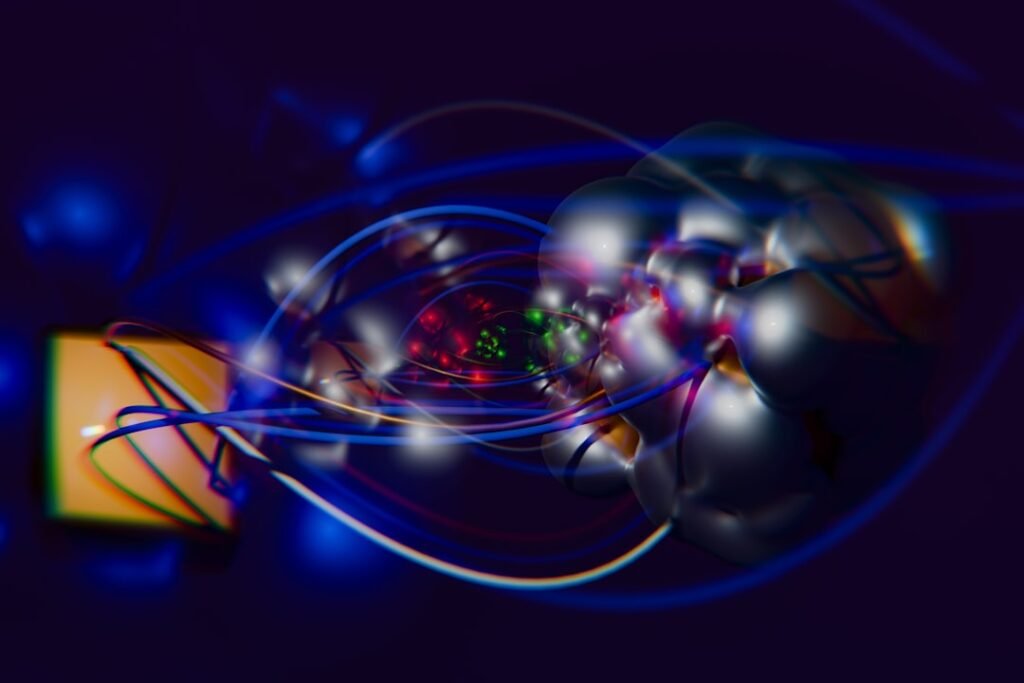Picture this: somewhere in the universe, two particles are dancing to a cosmic rhythm that defies everything you think you know about reality. When one spins up, the other spins down. When one changes direction, its partner responds instantly. Miles, continents, or even light-years might separate them, yet they remain forever connected in a mysterious quantum waltz.
This isn’t science fiction. It’s quantum entanglement, and it’s happening all around us right now. Once described by Einstein as “spooky action at a distance,” quantum entanglement may now seem less intimidating in light of new research findings, and it remains one of the most mysterious, counterintuitive, and yet experimentally confirmed features of our universe. You’re about to discover why this bizarre phenomenon continues to baffle scientists, revolutionize technology, and challenge our deepest beliefs about how the world actually works. Let’s dive in.
The Birth of a Physics Revolution

You might think quantum entanglement is a recent discovery, but its roots stretch back nearly a century. Later that same year, Einstein, Boris Podolsky and Nathan Rosen published a paper on what is now known as the Einstein–Podolsky–Rosen (EPR) paradox, a thought experiment that attempted to show that “the quantum-mechanical description of physical reality given by wave functions is not complete”. Shortly after this paper appeared, Erwin Schrödinger wrote a letter to Einstein in German in which he used the word Verschränkung (translated by himself as entanglement) to describe situations like that of the EPR scenario. The year was 1935, and these brilliant minds had stumbled upon something that would shake physics to its core.
What made Einstein so uncomfortable wasn’t just the strangeness of the phenomenon itself. Like Einstein, Schrödinger was dissatisfied with the concept of entanglement, because it seemed to violate the speed limit on the transmission of information implicit in the theory of relativity. Einstein later disparaged quantum mechanics for seemingly exhibiting “spukhafte Fernwirkung” or “spooky action at a distance”, meaning the acquisition of a value of a property at one location resulting from a measurement at a distant location. For Einstein, this violated a fundamental principle: nothing should travel faster than light.
What Makes Particles “Spookily” Connected

At its core, quantum entanglement defies classical intuition. In classical physics, objects have definite properties, and measuring one object doesn’t affect another. However, in the quantum realm, particles like electrons or photons can become entangled through specific interactions. Once entangled, measuring a property (such as spin or polarization) of one particle instantly determines the corresponding property of its partner, even if they are light-years apart.
If two particles are quantum entangled, it makes no sense to describe them separately. Even if you know the state of this two-particle system perfectly well, you cannot make a clear statement about the state of a single particle. “You could say that the particles have no individual properties, they only have common properties. Think of it like a cosmic coin flip where both particles somehow know the outcome before the coin even lands.
Mathematically, an entangled system can be defined to be one whose quantum state cannot be factored as a product of states of its local constituents; that is to say, they are not individual particles but are an inseparable whole. When entanglement is present, one constituent cannot be fully described without considering the other(s).
Einstein’s Famous Objection and the EPR Paradox

The concept of entanglement gained prominence through the Einstein-Podolsky-Rosen (EPR) paradox in 1935. Einstein, along with his colleagues Boris Podolsky and Nathan Rosen, presented a thought experiment challenging the completeness of quantum mechanics. They argued that if quantum mechanics were complete, it would imply “spooky action at a distance,” which seemed implausible.
To preserve these principles, Einstein and his collaborators proposed that quantum mechanics must be missing something – some “hidden variables” that determined the outcome of measurements in a deterministic way. They believed the spooky correlations predicted by entanglement were a sign that quantum theory was incomplete. Einstein famously quipped, “God does not play dice with the universe.” He simply couldn’t accept that nature operated on probability and mysterious connections.
But the physicist trio discovered something odd, now called the Einstein-Podolsky-Rosen (EPR) paradox: By studying Alice, you actually learn much more about Bob than you do about Alice. Later experiments using individual particles proved the physicists correct on this point.
Bell’s Theorem: The Game Changer

In 1964, physicist John Bell formulated Bell’s theorem, providing a way to test the validity of entanglement through inequalities that classical systems must satisfy. Quantum systems, however, can violate these inequalities. Subsequent experiments, notably those by Alain Aspect in the 1980s, confirmed these violations, reinforcing the reality of entanglement and challenging local hidden variable theories.
Bell’s Theorem showed that no theory of local hidden variables could reproduce all the predictions of quantum mechanics. In other words, if the universe obeys the rules of locality and realism – the belief that physical properties exist before being measured – then certain statistical outcomes must be true. When experiments violated these predictions, it proved Einstein wrong about hidden variables.
In 1964, Bell ironically proved that EPR’s argument actually led to the opposite conclusion from what EPR had originally intended to show. Bell showed that quantum entanglement is, in fact, incompatible with EPR’s notion of locality and causality. The universe, it turns out, is far stranger than Einstein ever imagined.
Mind-Bending Speed: How Fast Does Entanglement Really Work

The emergence of quantum entanglement is one of the fastest processes in nature. Scientists show that using special tricks, this can be investigated on an attosecond scale. We’re talking about timeframes so brief that light itself barely moves a tiny fraction of an atom’s width.
Scientists have managed to analyze ultrafast processes which up until now were considered to be ‘instantaneous’: When a laser pulse hits an atom with two electrons, one electron may be ripped out of the atom, while the other electron stays close to the nucleus. These two electrons can become entangled in such a way that the point in time, at which the electron was ejected from the atom, becomes uncertain and depends on the state of the other electron.
Yet here’s the fascinating paradox: while entanglement can form incredibly quickly, it’s as though the universe flips a coin and both particles decide on their outcome together – instantly – across any distance. This seems to imply that some form of faster-than-light communication is occurring, but that would violate Einstein’s theory of relativity, which forbids anything from traveling faster than light. The resolution lies in understanding that no information actually travels between the particles.
Recent Scientific Breakthroughs That Are Changing Everything

A study from Technion unveils a newly discovered form of quantum entanglement in the total angular momentum of photons confined in nanoscale structures. This is the first discovery of a new quantum entanglement in more than 20 years, and it may lead in the future to the development of new tools for the design of photon-based quantum communication and computing components, as well as to their significant miniaturization.
The results reveal that quarks and gluons, the fundamental building blocks that make up a proton’s structure, are subject to so-called quantum entanglement. This quirky phenomenon, famously described by Albert Einstein as “spooky action at a distance,” holds that particles can know one another’s state – for example, their spin direction – even when they are separated by a great distance. In this case, entanglement occurs over incredibly short distances – less than one quadrillionth of a meter inside individual protons – and the sharing of information extends over the entire group of quarks and gluons in that proton.
Scientists have finally unlocked a way to identify the elusive W state of quantum entanglement, solving a decades-old problem and opening paths to quantum teleportation and advanced quantum technologies. More than 25 years after the initial proposal concerning the entangled measurement for GHZ states, we have finally obtained the entangled measurement for the W state as well, with genuine experimental demonstration for 3-photon W states.
Quantum Teleportation: Science Fiction Becomes Reality

Only limited by the speed of light, quantum teleportation could make communications nearly instantaneous. The process works by harnessing quantum entanglement, a technique in which two particles are linked, regardless of the distance between them. Instead of particles physically traveling to deliver information, entangled particles exchange information over great distances — without physically carrying it.
Before Kumar’s new study, many researchers were uncertain if quantum teleportation was possible in cables carrying classical communications. The entangled photons would drown among the millions of other light particles. It would be like a flimsy bicycle trying to navigate through a crowded tunnel of speeding heavy-duty trucks. Kumar and his team, however, found a way to help the delicate photons steer clear of the busy traffic.
This is incredibly exciting because nobody thought it was possible. Researchers have now successfully demonstrated quantum teleportation over existing internet infrastructure, proving that we don’t need to build entirely new networks for quantum communication.
Real-World Applications That Will Transform Your Future

Quantum Teleportation: Through entanglement, quantum information can be transmitted between distant particles without moving through the intervening space, a process known as quantum teleportation. This phenomenon has been experimentally demonstrated, paving the way for advancements in quantum communication networks.
Quantum Cryptography: Entanglement forms the basis of quantum key distribution protocols, such as BB84, ensuring secure communication. Any eavesdropping attempt disrupts the entangled state, alerting parties to potential security breaches. Imagine communication so secure that any attempt to hack it automatically destroys the message.
The researchers demonstrated the effectiveness of the method by executing Grover’s search algorithm. This quantum method searches for a particular item in a large, unstructured dataset much faster than a regular computer can, using the quantum phenomena of superposition and entanglement to explore many possibilities in parallel. Its successful demonstration underscores how a distributed approach can extend quantum capabilities beyond the limits of a single device, setting the stage for scalable, high-performance quantum computers powerful enough to run calculations in hours that today’s supercomputers would take many years to solve.
Artificial Intelligence Discovers New Ways to Create Entanglement

Scientists have made a major breakthrough in quantum physics by using artificial intelligence to discover a simpler way to achieve quantum entanglement – a phenomenon Albert Einstein famously referred to as “spooky action at a distance.” Instead of merely replicating existing entanglement methods, the AI developed an entirely new, simpler technique for creating quantum links between particles. This discovery could significantly streamline the way scientists generate entanglement – one of the most crucial aspects of quantum technology.
Initially, the AI was tasked with reproducing known entanglement methods, but instead, it found a novel, simpler way to create quantum entanglement. Rather than requiring the usual Bell-state measurement, the AI found that entanglement could emerge naturally when photons traveled along indistinguishable paths. If multiple sources produced photons in such a way that their origins became indistinguishable, the entanglement could form without direct interaction between the particles.
The AI-driven breakthrough could dramatically simplify this process, making large-scale quantum networks more feasible. In other words, if entanglement can be generated more easily, then scaling up quantum networks becomes much more practical. This could lead to new high-speed, ultra-secure communication systems that would be impossible to hack using classical computing.
What This Means for Our Understanding of Reality

Quantum entanglement doesn’t just challenge physics – it shakes the foundations of philosophy. If measuring one particle affects another instantly, does that mean objects don’t have definite properties until we look? If so, is reality fundamentally subjective? These questions force us to reconsider everything we thought we knew about the nature of existence itself.
The famous ER=EPR conjecture, proposed by physicists Juan Maldacena and Leonard Susskind, suggests a deep link between entanglement (EPR) and wormholes (ER, for Einstein-Rosen bridges). In this view, entangled particles might be connected by microscopic wormholes – literally tunnels through spacetime. It’s a speculative but tantalizing idea: that the connectivity of the universe is built not from space, but from entanglement.
Our work presents a paradigm shift: the topology that has traditionally been thought to exist in a single and local configuration is now nonlocal or shared between spatially separated entities. They envisage that “this fresh perspective can serve as a labelling system for entangled states, akin to an alphabet!” We may be discovering that reality itself is far more interconnected than we ever imagined.
Conclusion

From Einstein’s initial skepticism to today’s quantum internet breakthroughs, entanglement has proven to be one of the most profound discoveries in human history. What started as “spooky action at a distance” has become the foundation for technologies that will reshape computing, communication, and our understanding of the universe itself.
The strangest part? We’re just getting started. As artificial intelligence discovers new ways to create entanglement and scientists probe deeper into quantum mysteries, we’re unlocking secrets that challenge the very nature of reality. The particles dancing their mysterious quantum waltz aren’t just fascinating curiosities – they’re the key to humanity’s technological future.
What do you think about quantum entanglement’s potential to revolutionize our world? Tell us in the comments.

Hi, I’m Andrew, and I come from India. Experienced content specialist with a passion for writing. My forte includes health and wellness, Travel, Animals, and Nature. A nature nomad, I am obsessed with mountains and love high-altitude trekking. I have been on several Himalayan treks in India including the Everest Base Camp in Nepal, a profound experience.




